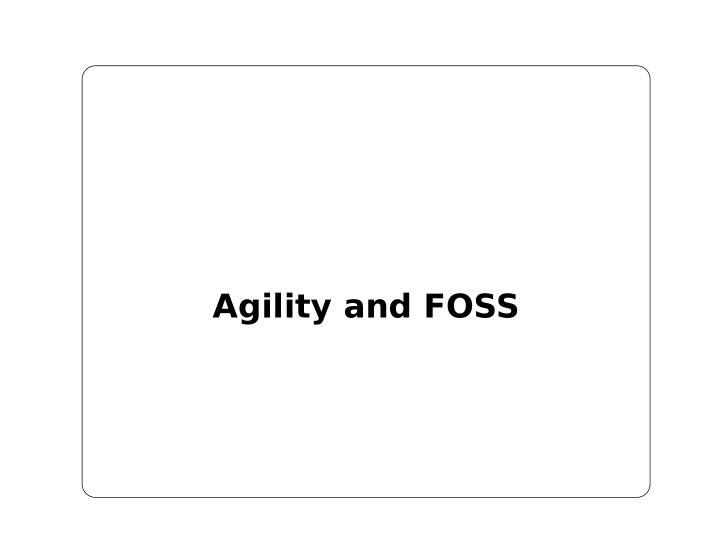



Agility and FOSS
whoami Haïkel Guémar Fedora Packager since 2006 Senior Software Engineer @ SysFera Certifjed "Scum" Master
Values
Agile Manifesto 4 values 1. Individuals and interactions over processes and tools 2. Working software over comprehensive documentation 3. Customer Collaboration over contract negotiation 4. Responding to change over following a plan
FSF Four Freedoms 1. The freedom to run the program for any purpose 2. The freedom to study how the program works and change it to make it do what you wish 3. The freedom to redisitribute copies so you can help your neighbor 4. The Freedom to improve the program and release your improvements to the public
Two attitudes Agile manifesto describe how to build better software FSF Four Freedoms how to respect users freedom
Common points • Similar Ethics • Focus on teamwork • Communication as pivot
Technically • Iteration vs "Release early, release often" • Empowerment of knowledge: "Software Craftmanship vs meritocracy"
FLOSS achievements • open code ◦ code review "Given enough eyeballs, all bugs are shallow" ◦ efgective collective ownership • broader community ◦ team ⊂ community
Agile for FLOSS hackers
Principles • iterative and incremental development • self-organizing and cross-functionnal teams • adaptative planning and delivery • timeboxed approach
Many Methods • eXtreme Programming • Crystal methods family • Kanban • Scrum (the trendy one)
eXtreme Programming Created in 1999 by Kent Beck
eXtreme Programming 4 values: • Communication • Simplicity • Feedback • Courage • Respect (added in Extreme Programming Explained, 2nd ed )
eXtreme Programming 12 practices: • Fine scale feedback ◦ Pair programming ◦ Planning game ◦ T est-driven development ◦ Whole team • Continuous process ◦ Continuous integration ◦ Refactoring or design improvement ◦ Small releases
eXtreme Programming 12 practices: • Shared understanding ◦ Coding standards ◦ Collective code ownership ◦ Simple design ◦ System metaphor • Programmer welfare ◦ Sustainable pace
eXtreme Programming Planning/Feedback Loops Release Plan Months Iteration Plan Weeks Acceptance Test Days Stand Up Meeting One day Pair Negotiation Hours Unit Test Minutes Pair Programming Seconds Code
Scrum An iterative and incremental agile software development framework coined by Jefg Sutherland and Ken Schawber in 1995
Scrum It has roles: • Product Owner: the guy who sets the vision • Scrum Master: the sheep herder • T eam: people who do the actual works • Stakeholders: people who pay/use your product
Scrum And meetings (don't worry, they're timeboxed !) • daily scrum • sprint planning • sprint review (aka demo) • retrospective
Scrum And artefacts: • Product backlog • Sprint backlog • Burndown chart
Scrum The process: 24 h 30 days Working increment Product Backlog Sprint Backlog Sprint of the software
Recommend
More recommend